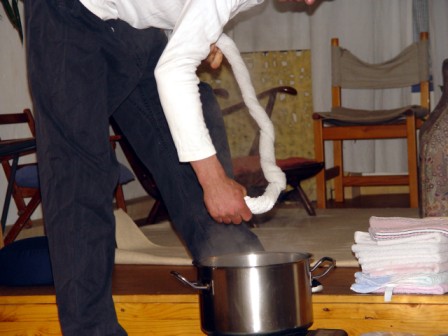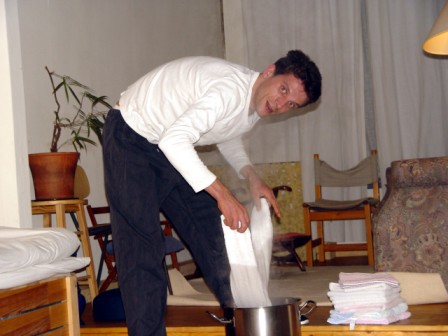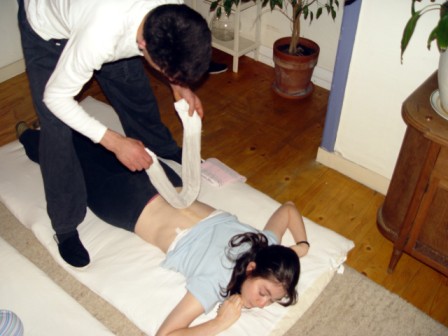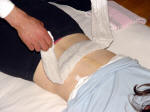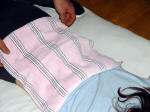Macrobiotic Home Remedies
Folk tradition is rife with natural healing techniques. Our magic glasses of yin and yang reveal how these remedies function and ways to devise our own concoctions.
Home remedies are made at home & work out to be less expensive than other alternative forms of medicines. Generally, homemade remedies are harmless when compared to other forms of modern medicines and rarely cause reactions or side effects. For ages herbal remedies & home made medicines have been used by our ancestors to cure common ailments.
Macrobiotic Home Remedies
- Ginger-Sesame Oil
- Ginger Compress
- Daikon Drink # 1
- Daikon-Lotus-Carrot Drink
- Leafy Greens Drink
- Sweet Vegetable Drink
- Ume-Sho-Kuzu
Ginger-Sesame Oil
This mixture activates the blood circulation for use in the case of:
- Falling hair and dandruff: Comb the hair into a part, dip a cloth into the mixture and rub the scalp briskly with it. Comb another part a ½ inch away and repeat. Continue over the entire scalp, treating the head 2x/week.
- Aches and pains: Ginger-sesame oil is especially good for muscular rheumatism, arthritis, and neuralgia, such as facial neuralgia. It prolongs the benefits of a ginger compress. It is also very good for relieving headaches—dip a cloth in the oil and rub the forehead with it.
- Mild ear infection—place one drop in the ear tube to calm down an inflammation.
Grate enough fresh ginger to press out 1 teaspoon of juice. Mix it with an equal amount of sesame oil. Shake well before use. If the mixture causes a burning feeling, reduce the amount of ginger to 10 drops per tablespoon of oil.
Ginger Compress
The ginger compress is very effective to dissolve stagnations, rejuvenate, soften and revitalize tissues.
A compress is an application to some surface part of the body, or a piece of cloth (linen or flannel) that has been dipped into a liquid and wrung out. A compress can be hot, in which case it is also called a fomentation, or it can be cold.
Fresh ginger root:
Ginger will stay fresh for a long time if you bury it in dry sand, in a flower pot for instance. Keep the pot in a cool, dry place. If you cannot find fresh ginger, use ginger powder.
Equipment:
- A large, heavy pot with a lid. The pot should hold at least one gallon (4 liters) of liquid, and should keep its contents hot. An enameled pot is preferable.
- A grater: an earthenware or a porcelain grater is preferable.
- One large, thick bath towel.
- Two or three smaller cotton kitchen towels.
- A small cotton bag with a small string to tie it, or a small cotton towel or cheesecloth with a piece of string or some rubber bands, or a white cotton sock that can be tied in a knot.
- Optional: rubber gloves, old newspapers or a piece of plastic (such as a kitchen bag).
Preparing Ginger Water:
Bring a liter of water to a boil in a covered pot. In the meantime wash some fresh ginger roots. Cut out any black spots, but you don't need to peel the root.
Grate the root. You will find that grating in a rotating motion is better than in a back and forth movement: if you grate back and forth, many ginger fibers start to build up on the grating surface, making it difficult to continue. To prepare one liter (one quart) of ginger water, you will need about 100-140 grams (3.5 to 5 oz) of grated ginger. This quantity cannot be standardized because the desired concentration of the ginger water can vary; also, because some roots are more juicy than others. If you are not able to obtain fresh ginger root, use about 1tablespoon of ginger powder per liter of water.
Wrap the grated ginger or ginger powder in the bag. Some people put the ginger directly in the hot water, however we find it handier, cleaner and safer not to do this. Particles of grated ginger tend to stick to the skin, causing an excessive irritation.
Wet the cotton bag, and insert the grated ginger (or ginger powder). Close the bag well. If you do not have a bag, put the ginger on the center of a damp cotton cloth or on the center of 2-3 layers of cheesecloth. Fold the corners to make a little bag, and close this bag with the string or some rubber bands. Do not fold the cloth too tightly around the ginger. There should be enough space inside to allow water to circulate throughout the contents.
Just before the water is about to boil, turn down the flame so that the water merely simmers gently. Please note that from this point on, whether preparing ginger water, applying ginger compresses or reheating ginger water, you should take care not to bring the liquid to a full boil. At the boiling point the active ingredients of ginger water are rapidly destroyed.
Uncover the pot. If you are using fresh grated ginger, squeeze the bag out well into the pot before dropping it in the hot water. Replace the lid. Let the water simmer for 5 minutes. The liquid will start to look yellowish, and it should start to give off the smell of ginger strongly. If this does not happen, squeeze the bag against the pot once or twice with a pair of chopsticks or with a wooden fork or spoon.
Turn off the flame when the liquid seems ready, and remove the pot. While you are applying compresses, the ginger water tends to cool off gradually. To be effective, a ginger compress must be applied fairly hot. It may therefore be necessary to reheat this water briefly, or you can add more boiling water to it. Alternatively, you can keep the ginger water hot by using an electric hot plate while applying the compresses. Although we generally discourage the use of electricity for preparing foods or drinks, it can be used in this case.
Ginger Water:
The liquid is now ready to be used for compresses. However, this ginger water could also be used for several purposes other than compresses:
- It could be added to bathing water for a full bath or for partial baths such as a hip bath, hand bath or footbath.
- It could be used for scrubbing the body once or twice a day.
Applying a Ginger Compress:
Be careful not to spill ginger water on a wooden floor as it damages the wood. To prevent this, put newspapers or plastic on the floor. The person who is receiving the compress should lie down comfortably. The area of the body which is going to be treated must be widely bared.
It is possible to apply ginger compresses on yourself, but it is much easier, safer and more effective if they are applied by a friend. In case you have very sensitive hands, or if you have to perform this treatment frequently, it may be better to wear rubber gloves. Otherwise, the ginger water will be beneficial to you as the giver when it touches your skin too.
Fold a cotton kitchen towel lengthwise in two or three folds. Remove the lid from the pot and dip the middle part of the towel in the ginger water while holding both ends. Lift out the towel and squeeze the excess water back into the pot. This needs a little practice because for best results you shouldn't remove too much or too little water. Replace the lid.
Unfold the towel for a moment. It should be steaming. Refold the towel to the desired width (depending on the area to be treated), and apply it directly on the skin. It should be as hot as the receiver can bear. If you are inexperienced, it is better to test the heat of the compress on yourself as follows: bring the compress near your face for a moment. If you can do this, you can be sure that the compress is not too hot. If you don't use this test, be very careful not to burn the receiver's skin. You should realize that some body areas can be burned without anyone knowing it. In particular the back is not very sensitive to heat. Also do not forget that some areas can be burned more easily, such as the breast or the genital area. It is definitely not the purpose of a ginger compress to burn the skin, but rather to apply as warm a compress as can comfortably be tolerated. If the surface to be treated is very large, you must immediately apply a second towel next to the first, or even a third towel next to the second.
In order to keep the heat in the compress for as long as possible, place one or even two bath towels on top of the compress. Or if you wish, you may apply a second compress on top of the first, and then cover both with a bath towel. Some people think it would be advantageous to cover the compress with a rubber sheet, or with vinyl or plastic, because this can keep the heat longer. This, however, is not good. It counteracts the purpose of the ginger compresses, and in some situations may even worsen the condition!
Using these techniques, the compress will stay hot for 3-10 minutes. In order to enhance the effect of the compress, some people recommend pressing the compress with both hands, or applying a light vibrating massage through the covering towel. We do not advise this. It is usually too bothersome or too painful for the receiver. As soon as the recipient no longer feels the heat of the compress, you must apply another one. Or you can, if you wish, prepare a new compress as soon as the first one has been applied. Then put on this new compress when it is ready, without waiting for the first one to cool off. In practical terms this means that you will be placing on a new compress every 3-4 minutes.
Duration of a Treatment:
Apply new compresses until the skin shows a lasting deep red color. Usually this takes about 20-30 minutes, and means that the compresses are exchanged 5-10 times. In some cases it is necessary to continue treatment much longer. To treat a chronic condition, 20-30 minutes may be sufficient, but to relieve acute situations such as an asthma crisis, or a discharge of a kidney stone, the treatment can be or must be continued much longer.
Ending a Treatment:
After each treatment all towels should be rinsed thoroughly and dried. Keep these towels separate and use them only for applying ginger compresses.
Ginger water is most potent for only two to three hours. If two or three treatments per day are necessary for a serious condition, you should prepare fresh ginger water for every treatment. For a less serious condition you can use the same ginger water several times during one day (i.e., 24 hours), but the next day you should prepare fresh liquid. However, do not discard day old ginger water. You can reheat it and then add it to a bath or use it for a footbath: soaking the feet in hot water (ginger water or plain hot water) and washing them with soap before going to bed secures a good sleep. You can also use day old ginger water in the morning: vigorously wash or scrub the body with it. This is very stimulating.
The Purpose and the Way of Action of a Ginger Compress:
The main purpose of a ginger compress is to strongly increase blood circulation and body fluids at areas where stagnation exists. This stagnation usually manifests itself in the form of pain, inflammation, swelling or stiffness.
It additionally helps to actively disperse stagnated energy, and to re-establish a good energy exchange between the body and the environment. The application of a rubber or vinyl sheet on top of a compress would hinder this energy exchange. It could even lead to a worsen the condition instead of relieving it! In this case, the heat of the compress activates the local energy, but its exchange with the environment is on the contrary hindered by the rubber or vinyl sheet. The active factors in a ginger compress are:
STRONG HEAT
Strong heat will dilate the blood vessels and thereby activate the movement of stagnated fluids. Strong heat will also melt or soften mucus stagnations and fatty accumulations and will tend to break up mineral crystallisations. Strong heat has the further advantage of penetrating deeply into the body. Thus a ginger compress can exert its influence deep inside the body, even within solid organs such as the kidneys and liver, or within the lungs.
GINGER
Due to its nature, ginger easily penetrates into the body. (We sometimes noticed a ginger smell in the breath of a person who had been treated with ginger compresses on the kidneys.) Because of its penetrating nature, ginger will also disperse stagnated yin substances such as mucus and fat accumulations. Ginger will further increase local circulation because it opens the blood vessels.
As a result of this double effect, thick liquids in the body start to liquefy, heavy deposits start to dissolve, stagnated liquids begin to move again, and gradually all treated tissues become cleansed and nourished with fresh blood. That is to say, tissues will gradually rejuvenate, soften and revitalize.
These stagnations and deposits originated in our way of living, primarily in our way of eating, especially by using too much meat, cheese, butter, sugar, eggs and milk. Everyone can benefit from the effect of a ginger compress, but to produce a lasting improvement we must also change our way of eating. However, even when we have been eating natural balanced wholesome food for years, not necessarily will all our hardenings, deposits, and stagnations caused by our past living habits disappeared. Their disappearance can be achieved by:
- Activity (work, exercises such as do-in, bicycling, etc.): this is the best way to increase our circulation in general.
- Controlling overeating and chewing your foods thoroughly.
- Ginger compresses: this may be one of the best ways to stimulate circulation at certain stagnated or tens locations.
- Shiatsu massage.
Indications-Specific Situations in which We can Use Ginger Compress:
Many types of acute or chronic pains can be relieved by ginger compresses, such as rheumatism, arthritis, backaches, cramps (intestinal cramps, menstrual cramps, etc.), kidney stone attacks, toothaches, stiff neck, and similar problems. If the pain worsens during the treatment, you should discontinue the compresses. Painful conditions in which a ginger compress is definitely not recommended are described a little further on.
Ginger compresses can speed up the improvement from a variety of inflammatory conditions: for instance bronchitis, acute or chronic liver inflammation, kidney inflammation, prostate infection, bladder inflammation, intestinal inflammations (but never in the case of appendicitis), boils and abscesses.
To relieve congestive conditions such as asthma. In case of an asthma attack the compresses can be continued for a long period, even for hours.
Ginger compresses can be extremely useful to dissolve hardened accumulations of fats, proteins or minerals. Examples of these are kidney stones, gallbladder stones, cysts (breast cysts, ovarian cysts) and benign tumors such as uterine fibroids.
To dissolve muscle tensions:
When tissues have been damaged, ginger compresses can speed up the regeneration of the damaged area. We noticed for instance tremendous benefits of ginger compress in the after-treatment of broken bones.
While ginger compresses by themselves can be a sufficient symptomatic help, often they need to be accompanied by another external treatment (such as a taro potato plaster) in order to have a good, lasting relief of symptoms.
Finally, we wish to stress once more that these compresses should not be considered as the only or most important factor in the treatment. They can give very effective symptomatic relief, but they do not remove the basic cause of the problem.
Counter-Indications–Situations in which Not to Apply Ginger Compress:
Most of these counter-indications were discovered over time by trial and error. If we understand the nature of the ginger compress, it is obvious why the use of a ginger compress is not appropriate in some situations.
Actually, ginger compresses are heat-producing applications. The ginger helps this heat to penetrate even further. It would therefore be wrong to apply a ginger compress on areas and in the following situations :
- Never apply a ginger compress on the brain-area. In the case of a headache caused by, for instance, a sinusitis, it is allowable to use a mild ginger compress on the facial area, or to use warm ginger water in the form of a facial scrub.
- Never apply a ginger compress on a baby or on very old people.
- Never apply a ginger compress on the lower abdominal area of pregnant women (this area is very active during this time).
- Never apply a ginger compress on an inflamed appendix (appendicitis) or on a lung affected by pneumonia. Both conditions are in the first place generated by the consumption of animal foods (meats, eggs, poultry, cheese)
- Never apply a ginger compress when a high fever is present. First of all you must try to reduce the fever.
- Finally, it is of extreme importance to remember that a ginger compress should never be applied on any cancerous tumor without medical or professional advise. If this would be done repeatedly, it would accelerate the metabolism, and the multiplication and movement of cancer cells. As a result an increased growth of the tumor and a more rapid spreading of the cancer cells could arise.
(Source: Macrobiotic Home Remedies-Michio Kushi/Marc Van Cauwenberghe, M.D.)
Daikon Drink #1
3 Tbsp grated daikon
½ Tbsp grated ginger (less if goal is to dissolve fat)
½ Tbsp shoyu
Lowers fever.
Antidote to food poisoning.
Eliminates fat.
Drink induces sweat—wrap yourself in a blanket and go to bed afterwards.
1-2 c/day, for NOT more than 3 days (too weakening).
- Prepare bancha tea—boil water, turn off flame, add bancha twigs, cover and let sit.
- Put other ingredients in a bowl or cup.
- Pour tea over ingredients; Strain and drink.
For children or conditions of tight liver or measles:
Give hot apple juice instead of daikon drink
Daikon-Lotus Carrot Drink
Daikon dissolves hard animal fat in the body.
Lotus dissolves dairy mucus.
Carrot enhances effect of daikon without being as weakening.
- Grate equal amounts of each vegetable, 1/3 cup each. (If not using lotus root, use ½ cup carrot and daikon).
- Boil in pot with 1 cup of water.
- Add 1/3 chopped big umeboshi plum.
- Add 1/3 sheet unroasted nori torn into pieces.
- Lower flame and cook, covered, 3 minutes.
- Eat while hot.
- 3 x/week for one month.
Leafy Greens Drink
Relaxes tight liver.
Dissolved animal fat and protein.
Light tree energy.
- Chop 2-3 kinds of greens as finely as possible, ½ cup each.
- Boil 2 x as much water as the amount of greens.
- Add greens to boiling water; Return to boil, cover, and simmer 4-5 minutes.
- Add 4-5 grains of salt of 2 drops of shoyu after 2-3 minutes.
- Strain and squeeze out liquid from vegetables.
- Sour apple also relaxes tight liver as a dessert or medicine.
- Do not add salt as remedy to relax tight condition.
Greens drink
- Relaxes a tight liver; Use for yellow skin, impatience, anger, old animal fat or protein still stored in the liver.
- Heat 1 cup water to a boil.
- Chop finely ½ cup of any leafy green(s) and add to the boiling water.
- Cover and boil 3-5 minutes; Add pinch of salt during the last minute only in order to keep the yin quality of the drink.
Sweet Vegetable Drink
- This drink is good for softening tightness caused by heavy animal food consumption and for relaxing the body and the muscles. Make enough for 3 days and store it in the back of the refrigerator.
- Use equal amounts of four sweet vegetables, finely chopped onion, carrot, squash, and white cabbage (no salt).
- Boil 1 cup of water and add ¼ cup diced onion. Let the strong smell dissipate with an open lid.
- Put in ¼ cup diced carrot and another cup of water. Bring the water to boil.
- Add ¼ cup diced squash and bring another cup of water to a boil.
- Add ¼ cup diced cabbage and bring a fourth cup of water to a boil.
- Lower the flame and let cook for 20 minutes.
- Strain out the vegetables from the broth and squeeze out their remaining liquid. Discard the vegetables.
- Drink ½ cup of the broth room temperature or warmed up, twice a day, mid-morning and mid-afternoon.
Medicinal Drinks
Drink ¼ to 1/3 cup at a time, not more; otherwise it is too much liquid.
Testimonial: Positive Effects of Sweet Vegetable Drink
- First of all, I had much less tension in my muscles and felt more relaxation. I used to have tight shoulders, and after 4 weeks of sweet vegetable drink twice a day, my shoulders are MUCH softer & relaxed. My body in general is more relaxed from the inside. When I drive, for example, my body feels less tense than before).
- My craving for sweets is almost completely gone. I eat less desserts & smaller quantities than before, also due to reducing my salt intake.
- I feel it helps me to be more patient, since this drink is so calming.
Ume Sho Kuzu
Strengthens digestion.
Neutralizes all conditions - centering remedy.
Lowers fever.
Vomiting: The person will probably vomit once more; repeat ume sho kuzu. If vomiting still continues, give sweet vegetable drink or green drink to relax liver
For dysentery - Give ume plum in addition to ume sho kuzu.
Use less plum and shoyu for children’s remedy.
- Mash in a suribachi or chop into a bowl ½ big plum or whole small one.
- Place 1 cup of water in a pot.
- Dissolve 1 heaping spoon of kuzu and whisk or stir while heating.
- When boiling and transparent, add 6-8 drops shoyu.
- Cook while stirring 1 minute.
- Pour over umeboshi and stir.
- Let sit one minute before drinking.
- Optional: Add ginger toward the end for strengthening, except for cancer patients
Ume-Sho-Kuzu with Ginger:
- Cook 1 cup water with 1 heaping tsp. kuzu
- Add about 6 chopstick drops of tamari to liquid toward end of cooking
- Finely grate peeled ginger and squeeze juice over ½ to 1 chopped umeboshi in a cup
- Pour liquid over umeboshi, stir well and drink

